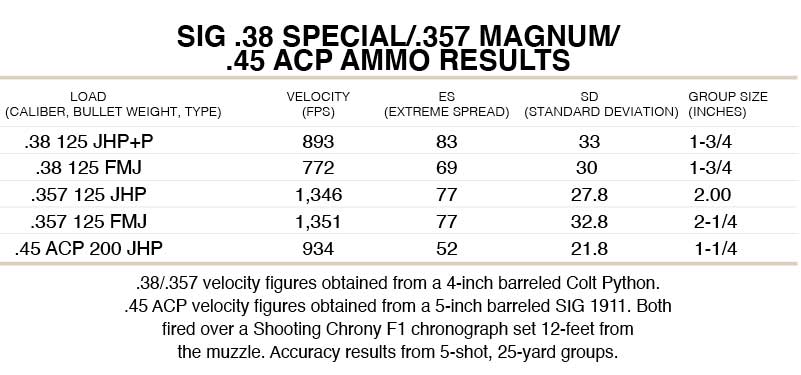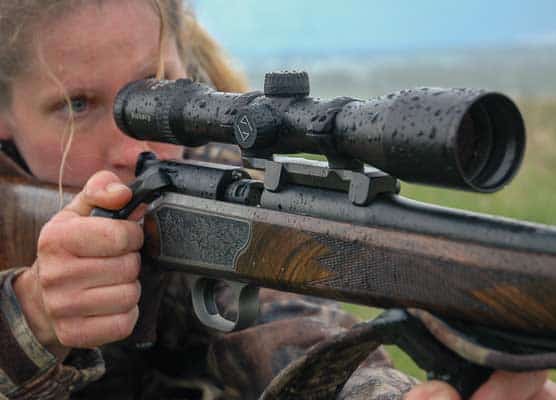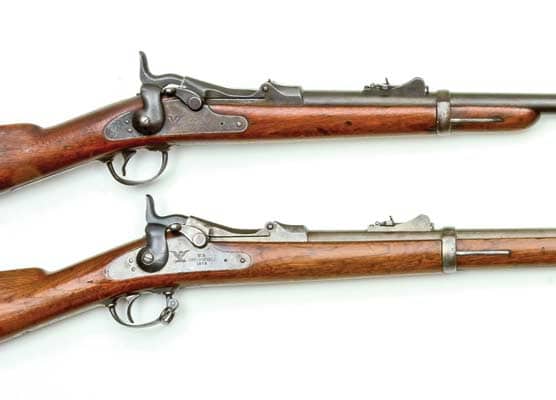A Gunny Grab Bag
A little bit of everything: ammo,
cleaning gizmos and musical connections
Of the world’s major gun companies, SIG SAUER may well have the most diverse product line. It includes pistols, rifles, airguns, apparel, and recently they’ve added optics, suppressors, and now, ammunition. Their Elite Performance line includes the “usual suspects” lineup of auto pistol calibers. And even though revolvers are just about the only thing SIG doesn’t offer, they do have revolver-centric ammo, featuring their V-Crown JHP and FMJ bullets.
We shot their .38 Special/.357 Magnum offerings out of a late-1960’s vintage 4-inch Colt Python with a proven propensity for 125-grain bullets. And in the interests of brand uniformity, we opted for a SIG 1911 for the .45 ACP stuff. Since we seldom get a chance to play with Colt’s classic (and sorely missed) high-end revolver, we went with the Python first.
In an era where folks still argue over the relative merits of 9mm, .40 S&W and .45 ACP autos, the old .357 Magnum sometimes gets lost in the shuffle. This is probably due as much to the ascendancy of autos in the self-defense/law enforcement sector as anything else. But numbers are numbers and the “original mag” is still a top-tier, high-pressure item. It’s not easy to control—although the hot 125-grain loads are a bit gentler than full-house 158’s. And yes, they’re blasty as heck—especially from 4-inch and shorter barrels. But no question, the .357 is powerful, to the point where using it in any revolver smaller than medium-frame has no appeal to me whatsoever. In fact, I’ve treated .357’s of nearly any frame size like a .38 anyway. They generally see a lot more +P Specials than they do the longer, louder ones. But every now and again, it’s nice to up-the-game a bit—particularly when you’re using Colt’s premier DA .357.
Twenty-five-yard accuracy from the .38 and .357 offerings were good. Since the FMJ standard-pressure .38 load is obviously intended as a surrogate practice load for the +P JHP and comes in a 50-round box, we were gratified to see its point-of-impact reasonably close. In other words, we didn’t think fiddling with the Python’s target-type adjustable sights was really called for.
Just for grins, we chronographed the .357 FMJ load from the 18-1/2-inch barrel of a Ruger 77/357 we had along for the ride. It ran just under 1,800 fps, prompting Thomas Mackie’s joking observation, “Say, it’s almost a real rifle now!”
The lone .45 ACP load, however, turned out to be a showstopper, grouping barely over an inch at 25 yards. And even if it hadn’t turned out to be such a tackdriver from our particular pistol, the 200-grain JHP strikes us a pretty good compromise between the quicker 185 and the bumpier 230-grain.
LET ’ER RIP
Otis has come up with a very interesting and effective concept on the “pull-thru” bore-cleaning concept. The Ripcord is a breech-to-muzzle cord, featuring a molded rubberized core and a Nomex fiber cover combined with a flex cable. The helix-shaped core keeps the cleaning fibers pressed tight against the bore for maximum scrubbing power. It’s designed for quick, in-the-field use and can be had in variety of gauges and calibers—.22/.223, .243, .270/6.8mm, .308, .38/9mm, .40 and .45 as well as 12-gauge. The threaded end fittings will accept all Otis cleaning accessories. My particular choice was their slotted fixture for a solvent-soaked patch, which cleaned out a fairly grubby Remington 870 bore in short order. The price is $14.99.
Blues Gone Ballistic
Back in 1954, the great Howlin’ Wolf (aka Chester Burnett) hammered out the definitive version of the classic, Forty Four. The birth of this caliber-conscious electrified stomper took place in Sam Phillips’ iconic Sun Records studio in Memphis, Tennessee—the same unassuming building where Johnny Cash, Elvis Presley, Jerry Lee Lewis, Junior Parker and Rufus Thomas also recorded:
“I wore my forty-four so long, I’ve made my shoulder sore
Well, I’m wondrin’ everybody, where’d my baby go?
Well, I’m so mad this mornin’, I don’t know where in the world to go
Well, I’m lookin’ for me some money, pawned gun to have some gold”








